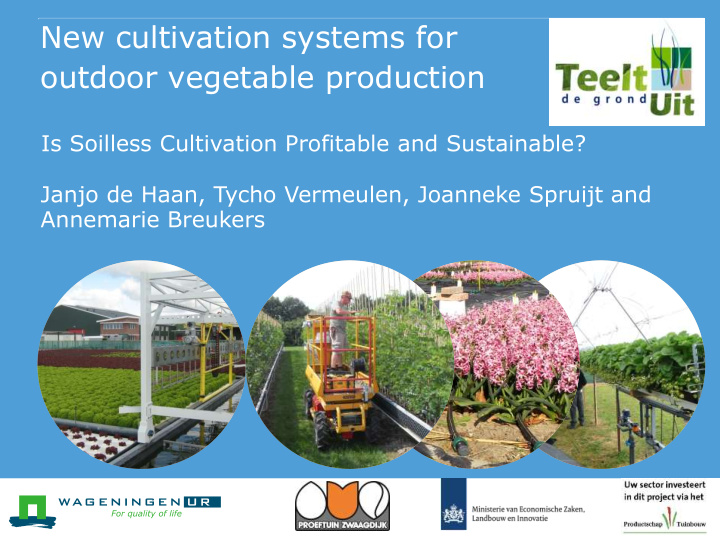



New cultivation systems for outdoor vegetable production Is Soilless Cultivation Profitable and Sustainable? Janjo de Haan, Tycho Vermeulen, Joanneke Spruijt and Annemarie Breukers
Content Current Crop Profitability and Production Sustainability New Cropping Systems Conclusions
Outdoor horticulture in the NL Tree nursery Fruit Flower Field crops & flowers crops bulbs vegetables
Growers Problems: Market requirements
Growers Problems: Financial Return
Growers Problems: Labour
Growers Problems: Soil Quality
Societal Problems: Water Quality N groundwater N and P surface water
Nitrate directive can not be realized within current cropping systems Nitrate concentration Balance groundwater (mg/litre) (euro/ha) 140 1600 1400 120 1200 100 1000 80 800 60 600 40 400 200 20 0 0 Experiment Farm Conventional Organic GI Hoog GI Laag Praktijk GI BIO Manure Chem fert Average
Growers initiated research
Research program Objective Develop and implement profitable new cultivation systems that can comply with EU-regulations for water quality Outdoor horticulture Duration: 2009-2013 Execution: Researchers, growers, advisors, suppliers Financed by ● Government ● Product boards of growers ● Various other parties
Program activities Systematic design, testing and improving of cultivation systems Advice to growers who start with these systems Sustainability assessments Societal aspects ● Consumer perspectives ● Laws and regulations (Spatial planning) Together with growers, suppliers, government and NGO’s
First experiments in 2007
Deep Flow Systems
Lettuce and other planted leaf crops
Lettuce and other planted leaf crops
Lettuce and other planted leaf crops
Development DF-system leaf crops Disease control ● Microdochium panattonianum Long term use nutrient solution Pesticide accumulation Composition plant plugs and position in floater Fertilization strategies
Leek
Cauliflower
Sown leaf crops: rocket leaf or spinach
Profitability and Sustainability Yields Profitability ● Cost price ● Profitability Labour demand Sustainability Planet ● Pesticide use ● Emission reduction ● GHG-emissions Societal aspects
Yield levels soil deep flow factor unit bound system Leek 65 286 4.4 tons/ha/year Head 1 000 170 684 4.0 lettuce heads/ha/year Spinach 114 125 1.1 tons/ha/year 1 000 Cauliflower 21 40 1.9 heads/ha/year
Relative cost price capital goods 350% land 300% labour 250% transport seed, fertilizers, pesticides, energy 200% ? 150% ? 100% 50% 0% soil DF soil DF soil DF soil DF Leek Head lettuce Spinach Cauliflower leek head lettuce spinach cauliflower
Labour demand 100 harvesting 80 crop care 60 planting 40 ? tillage 20 0 soil DF soil DF Leek Lettuce leek lettuce Hours/10 000 kg Hours/10 000 pieces
Relative pesticide use 30% 25% 20% 15% 10% 5% 0% leek head lettuce spinach cauliflower
Water management and emissions Potentials for emission reduction are high • Goal of 50-70% reduction possible to reach • Exact estimations are difficult Focus point Solution Pests and diseases ‘Vital systems’ • • Mismatch nutrients Fertiliser choice • • Na + accumulation Water management • • Rainfall surplus Cover the system • • management Water level management •
Solutions for rainfall surplus management
Relative green house gas emissions 350% 300% 250% 200% 150% 100% 50% 0% leek lettuce spinach cauliflower
Overall sustainability Proved Indication • Nutrient & pesticide • Land use emissions • Labour Better • Adaptation to conditions climate change • Pesticide use • Water use • Labour hours Comparable • Profitability • Energy use and To improve / GHG-emissions worse • Financial risks
Consumer perspectives
Communication and landscaping important
Laws and regulations: Spatial planning Current legislation impede the realization of new cultivation systems at large scale Municipalities/provinces have difficulties to follow new developments ● Fear to loose control Communication of advantages of the systems important ● Delineate the advantages of the system ● Connect picture with regional challanges Accept that systems have to be concentrated in specific locations
Conclusions Vegetables can be grown well on DF systems ● Some technical problems still to solve Potential for large emission reduction Large production increase needed for ● Profitability ● Bulk production yet not profitable ● Development via niche markets ● Sustainability ● GHG-emissions
Further outlook Guidance of growers in implementing cultivation systems Further improvement of cultivation systems ● Resilient systems ● Closing cycles (water, nutrients, energy, materials) Dialogue with society ● Communication on advantages ● Adapting systems to wishes of society
Thank you for listening
Recommend
More recommend